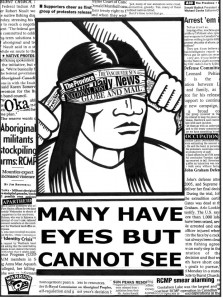By Karen Nickel
Dialog Reporter
Indigenous resistance occurs when First Nations, Métis, or Inuit Peoples act to: resist assimilation, retain their cultures, define their identity and defend territory in the face of state, corporate and settler incursions. It takes many forms and is often met by state violence, criminalization and lawsuits.

Illustration by Gord Hill
In 1995, at Ts’ Peten (Gustafsen Lake, British Columbia) in Secwepemec (Shuswap) territory, a conflict occurred between native and non-native people over a piece of land considered sacred for performing the Sun Dance ceremony. Canada’s response was to isolate, smear their character and engage in the largest military operation seen to that point. Canada used landmines, terrorized the Shuswap people with thousands of bullets, helicopters, snipers and armoured carriers and criminalized the Shuswap through the courts for engaging in the defence of their unceded territory.
After the trial, John “Splitting the sky” Hill, went on a B.C. public access program asking for a public inquiry saying “A number of people involved in this situation… should be charged with attempted murder.” There was no inquiry.
A different tactic was used in December 2002, when the Grassy Narrows First Nation set up a blockade on a logging road. The community had experienced mercury poisoning, relocation and now the declining ability to live off the land due to industrial clear cutting. Pressure was put on the logging company and the government through petitions, delegations, and a legal challenge.
As the blockade continued, the community organized a boycott of Grassy Narrows’ wood products that resulted in 2008 with the company terminating its licence to log. In 2011, the community won their court case in Ontario Supreme Court. Grassy Narrows First Nation ‘celebrated’ their tenth year anniversary of blockading in December 2012.
On Jan. 14, Grass Narrows issued a press release telling how the Ontario government began their appeal to overturn the
In 2006 in the territory of the Six Nations of the Grand River, at Kanonhstaton, (Caledonia) the Ontario government gave developers the go ahead to develop a housing estate without consulting the Haudenosaunee (Six Nations). Haudenosaunee members then occupied the development, calling for federal and provincial consultations. Confrontations erupted sporadically between non-native protesters and land defenders. Consultations with the Haudenosaunee began, but the province walked away from talks and things have stalled.
In 2011, the Ontario government paid $20 million to businesses and developers to cover lost costs. Haudenosaunee land defenders, on the other hand, have been arrested, criminalized and not allowed back to Kanonhstaton due to restrictive bail conditions.
In February 2012, while trying to block activist Gary McHale from trespassing, Theresa “Toad” Jamieson, was charged by the OPP with assault. Francine “Flower” Doxtater was charged with “intimidation” and breach of bail conditions charge because she attended a “Peace, Respect and Friendship” walk.
On Feb. 18, Idle No More brought people to Cayuga, Ontario, for a round dance in support of Toad. “The courts have no jurisdiction over me, because my laws are the Two Row Wampum and The Great Peace; not your laws” she said at court.
Toad, Flower and countless other Indigenous Peoples have never been idle. Toad goes back to court on July 3, two days after Canada Day. We talked about bringing a happy birthday card with her to court; she thought that was pretty funny.
This is the final part of a series on Indigenous resistance. Read part one here.


